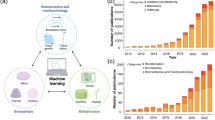Abstract
Purpose of Review
The purpose of this review is to examine five stages of process improvement in bioengineering of cellular products that could facilitate standardization and accelerate progress through the regulatory pathways and together make such treatments more widely available.
Recent Findings
We present solutions to reduce costs, promote standardization, and enable acceleration through the required regulatory pathways.
Summary
Regenerative medicine-based technologies and products have the potential to revolutionize the practice of medicine and become the next standard of care. We identify current barriers that are limiting the widespread availability of these potential life-saving treatments and platform technologies. One central barrier is the cost of manufacturing these regenerative medicine-based technologies and products at commercial scale.
Similar content being viewed by others
References
Papers of particular interest, published recently, have been highlighted as: •• Of major importance
Radenkovic D, Solouk A, Seifalian A. Personalized development of human organs using 3D printing technology. Med Hypotheses. 2016;87:30–3.
•• Culme-Seymour EJ, Mason K, Vallejo-Torres L, Carvalho C, Partington L, Crowley C, et al. Cost of stem cell-based tissue-engineered airway transplants in the United Kingdom: case series. Tissue Eng Part A. 2016;22(3–4):208–13. Provides some of the first cost analysis for manufacutring a tissue-engineered organ
Karnieli O, Friedner OM, Allickson JG, Zhang N, Jung S, Fiorentini D, et al. A consensus introduction to serum replacements and serum-free media for cellular therapies. Cytotherapy. 2017;19(2):155–69.
Eaker S, Abraham E, Allickson JG, Brieva TA, Baksh D, Heathman TRJ, et al. Bioreactors for cell therapies: current status and future advances. Cytotherapy. 2017;19:9–18.
•• Skardal A, Devarasetty M, Kang HW, Mead I, Bishop C, Shupe T, et al. A hydrogel bioink toolkit for mimicking native tissue biochemical and mechanical properties in bioprinted tissue constructs. Acta Biomater. 2015;25:24–34. Illustrates a modular hydrogel system for tailoring bioinks that could be used to create tissue-specific constructs that could be used as disease models, for personalized medicine or drug screening systems.
Chimene D, Lennox KK, Kaunas RR, Gaharwar AK. Advanced bioinks for 3D printing: a materials science perspective. Ann Biomed Eng. 2016;44(6):2090–102.
Mir TA, Nakamura M. Three-dimensional bioprinting: toward the era of manufacturing human organs as spare parts for healthcare and medicine. Tissue Eng Part B Rev. 2017.
Panwar A, Tan LP. Current status of bioinks for micro-extrusion-based 3D bioprinting. Molecules. 2016;21(6).
Nebraska Organ Recovery, Acceptable Ischemic Times [Available from: http://www.nedonation.org/donation-guide/organ/acceptable-ischemic-times.]
Mazur P. Freezing of living cells: mechanisms and implications. Am J Phys. 1984;247(3 Pt 1):C125–42.
Tanaka R, Takahashi N, Nakamura Y, Hattori Y, Ashizawa K, Otsuka M. In-line and real-time monitoring of resonant acoustic mixing by near-infrared spectroscopy combined with chemometric technology for process analytical technology applications in pharmaceutical powder blending systems. Anal Sci. 2017;33(1):41–6.
•• Zhang YS, Aleman J, Shin SR, Kilic T, Kim D, Mousavi Shaegh SA, et al. Multisensor-integrated organs-on-chips platform for automated and continual in situ monitoring of organoid behaviors. Proc Natl Acad Sci U S A. 2017;114(12):E2293–E302. Provides a multisensor system that could be developed for providing real-time, non-destructive monitoring of a regenerative medicine manufacturing process. This article focuses on monitoring organoid behaviors which are miniaturized organs.
Author information
Authors and Affiliations
Corresponding author
Ethics declarations
Conflict of Interest
Joshua G. Hunsberger, Sandeep Goel, Julie Allickson, and Anthony Atala declare that they have no conflict of interest.
Human and Animal Rights and Informed Consent
This article does not contain any studies with human or animal subjects performed by any of the authors.
Additional information
This article is part of the Topical Collection on Artificial Tissues
Rights and permissions
About this article
Cite this article
Hunsberger, J.G., Goel, S., Allickson, J. et al. Five Critical Areas that Combat High Costs and Prolonged Development Times for Regenerative Medicine Manufacturing. Curr Stem Cell Rep 3, 77–82 (2017). https://doi.org/10.1007/s40778-017-0083-7
Published:
Issue Date:
DOI: https://doi.org/10.1007/s40778-017-0083-7




